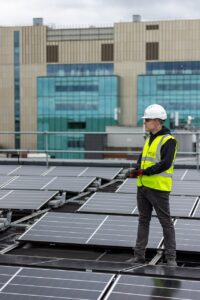Solar energy is becoming an increasingly popular and viable alternative to traditional forms of energy. As the world looks for greener and more sustainable solutions, the question of what impact solar energy has on the environment remains of paramount importance. In this article, we will explore the various aspects of solar energy and examine its potential environmental effects. From the reduction of greenhouse gas emissions to the impact on land and water resources, we will delve into the fascinating world of solar energy and uncover its environmental implications.

1. Land Use and Habitat Loss
Loss of natural habitats
Solar energy projects often require large amounts of land, which can result in the loss of natural habitats. These habitats, such as forests, wetlands, and grasslands, are home to diverse plant and animal species. When these natural habitats are cleared to make way for solar panels, it can disrupt entire ecosystems and lead to the displacement or extinction of species.
Conversion of agricultural land
In some cases, solar energy projects may be built on agricultural land. This conversion of land from farming to solar energy production can have significant implications for food production and food security. It may lead to a decrease in agricultural productivity and the loss of valuable farmland, which can impact local communities and economies reliant on agriculture.
Impact on wildlife populations
The installation and operation of solar energy systems can have direct and indirect impacts on wildlife populations. Large-scale solar projects often involve the installation of extensive infrastructure, such as transmission lines and substations, which can fragment or destroy habitats and disrupt wildlife migration patterns. Additionally, the reflective surfaces of solar panels can confuse and disorient birds, leading to collision-related fatalities.
2. Water Use
Water requirements during manufacturing
The manufacturing process of solar panels requires various stages that involve the use of water. This water is used for cleaning, cooling, and rinsing during the production process. While the amount of water used may vary depending on the type of solar technology and manufacturing methods, it can contribute to water scarcity in areas already facing water stress or limited water resources.
Water requirements during operation
Solar energy systems also require water for cleaning and maintenance purposes during their operational lifetime. Regular cleaning of solar panels is necessary to maximize energy production, and water is often used for this purpose. In locations where water availability is a concern, the water requirements of solar energy systems can exacerbate existing water scarcity issues.
Effects on local water resources
The extraction of water for solar energy production, both during manufacturing and operation, can have a significant impact on local water resources. It can deplete groundwater reserves and put strain on surface water sources, which are essential for the survival of local ecosystems and support human needs. Additionally, the discharge of wastewater from solar panel manufacturing can contribute to water pollution if proper treatment measures are not in place.

3. Raw Material Extraction
Mining and extraction processes
The production of solar panels requires the extraction of various raw materials, including silicon, silver, aluminum, and glass. The mining and extraction of these materials can have detrimental effects on the environment, such as habitat destruction, soil erosion, and water contamination. Additionally, mining practices can result in the release of harmful pollutants and greenhouse gas emissions.
Impact on ecosystems and biodiversity
The extraction of raw materials for solar energy production can lead to the destruction and fragmentation of natural habitats, resulting in the loss of biodiversity. Mining activities can disrupt ecosystems and disturb wildlife populations, leading to the displacement or extinction of species. Furthermore, the use of certain chemicals in the extraction process can have long-lasting impacts on the surrounding environment.
Pollution and waste generation
The production of solar panels generates waste and pollution at various stages, including during the extraction of raw materials and the manufacturing process. Toxic chemicals and heavy metals used in solar panel production can contaminate air, water, and soil if not properly managed. Additionally, the disposal of end-of-life solar panels can contribute to electronic waste, which poses environmental and health risks if not handled responsibly.
4. Energy Intensity of Manufacturing
Energy consumption during production
The manufacturing of solar panels requires significant energy inputs, which are often obtained from fossil fuel sources. The extraction, processing, and transportation of raw materials, as well as the manufacturing process itself, contribute to the energy intensity of solar panel production. This reliance on fossil fuels during manufacturing can offset the environmental benefits of solar energy usage and contribute to greenhouse gas emissions.
Greenhouse gas emissions from manufacturing
The manufacturing process of solar panels can result in greenhouse gas emissions, primarily through the use of fossil fuels for energy generation. The extraction and transportation of raw materials, as well as the production and assembly of solar panels, all contribute to carbon dioxide emissions. Additionally, the release of certain gases during the manufacturing process, such as nitrogen trifluoride, can have a significant impact on global warming potential.
Use of toxic chemicals
The manufacturing process of solar panels involves the use of various toxic chemicals, including solvents, acids, and heavy metals. These chemicals can pose health risks to workers and surrounding communities if not handled properly. There is a need for stringent safety measures and proper waste management practices to prevent the release of toxic materials into the environment and protect human health.

5. Pollution and Waste
Toxic materials in solar panels
Solar panels contain various toxic substances, such as lead, cadmium, and selenium, which can pose a risk to human health and the environment if not properly managed. These toxic materials can leach into the soil and water if solar panels are damaged or not disposed of correctly. Proper recycling and disposal methods are essential to prevent the release of hazardous materials into the environment and minimize the potential for contamination.
Electronic waste and disposal
As solar panels reach the end of their lifespan, they become electronic waste, also known as e-waste. The disposal of e-waste is a global challenge, as improper handling can lead to pollution and health hazards. The recycling and responsible disposal of solar panels are critical to minimize the environmental impact and ensure the safe management of hazardous materials.
Contamination of soil and water bodies
Improper disposal of solar panels can result in the contamination of soil and water bodies. Toxic substances leached from damaged or discarded solar panels can seep into the soil, potentially reaching groundwater reserves and polluting water bodies. Contamination of soil and water can have detrimental effects on ecosystems, as well as pose risks to human health if these resources are used for agriculture or drinking water.
6. Carbon Footprint
Embodied carbon emissions
The carbon footprint of solar energy includes not only the emissions resulting from its use but also the embodied emissions associated with its manufacturing and installation. The extraction of raw materials, transportation, and energy-intensive manufacturing processes all contribute to the embodied carbon emissions of solar panels. It is essential to consider the full lifecycle emissions when assessing the environmental impact of solar energy systems.
Lifecycle assessment of solar energy systems
A comprehensive lifecycle assessment (LCA) of solar energy systems takes into account the environmental impacts from cradle to grave. This assessment includes the extraction and production of raw materials, manufacturing, transportation, installation, operation, and end-of-life disposal. A thorough LCA provides valuable insights into the carbon footprint, energy use, and environmental impacts of solar energy, allowing for informed decision-making and the implementation of mitigation strategies.
Comparisons with other energy sources
When evaluating the environmental impact of solar energy, it is important to compare it with other energy sources. Solar energy generally has lower greenhouse gas emissions compared to fossil fuel-based energy sources like coal and natural gas. However, the extraction of raw materials, manufacturing processes, and waste management practices associated with solar energy must be carefully considered and improved to fully realize the potential environmental benefits.
7. Visual Impact
Aesthetics and landscape changes
The installation of solar energy systems can alter the visual landscape of an area. Large-scale solar projects may cover vast expanses of land with solar panels, which can be visually disruptive in natural or scenic areas. The visual impact of solar installations is subjective, and public perception varies. Balancing the need for renewable energy with preserving the aesthetic qualities of landscapes is a challenge that requires careful planning and consideration.
Reflection and glare issues
The reflective surfaces of solar panels can cause glare, which can be disruptive and potentially hazardous, particularly in areas where solar projects are located near roadways or airports. Glare from solar panels can affect drivers’ visibility, interfere with the operation of air traffic control systems, and have implications for both safety and aesthetics. Proper design and siting of solar energy systems can help minimize glare and mitigate these issues.
Public perception and acceptance
The visual impact of solar energy systems can influence public perception and acceptance of renewable energy projects. While some individuals may appreciate the transition to clean energy and view solar installations as positive contributions to combating climate change, others may have concerns about the visual impact on the landscape. Engaging with local communities, addressing concerns, and incorporating feedback in the project planning and design stages can help foster greater public acceptance of solar energy.
8. Noise Pollution
Noise levels during installation
The installation of solar energy systems can temporarily contribute to noise pollution in the surrounding area. Construction activities, such as the use of heavy machinery and equipment, can generate noise that may impact nearby residents or wildlife. Proper planning and implementation of construction practices can help minimize noise levels and reduce the potential disruption to local tranquility.
Inverter and transformer noise
The operation of solar inverters and transformers, which convert the direct current produced by solar panels into alternating current for use, can generate noise. This noise can vary depending on the scale and design of the solar energy system, as well as the proximity to residential areas. Advanced technology and appropriate noise mitigation measures can help minimize the impact of inverter and transformer noise on surrounding communities.
Impact on local tranquility
Noise pollution from the installation and operation of solar energy systems can have an impact on the local tranquility of an area. Excessive noise can disrupt the well-being of nearby residents, disturb wildlife, and adversely affect recreational activities in the vicinity. Mitigation measures, such as noise barriers or consideration of noise impacts during the site selection process, can help preserve the tranquility of the local environment.
9. Cultural and Archaeological Concerns
Effect on cultural heritage sites
Solar energy projects may be sited in areas with cultural heritage sites, including archaeological sites, historic structures, or culturally significant landscapes. The construction and operation of solar installations in close proximity to these sites can risk damaging these cultural resources. It is crucial to conduct thorough cultural heritage assessments, consult with relevant stakeholders, and implement protective measures to mitigate potential impacts and preserve cultural heritage.
Protection of archaeological artifacts
The development of solar energy projects may involve the excavation and ground disturbance that can potentially impact archaeological artifacts buried beneath the surface. Diligent archaeological surveys and excavations should be conducted prior to construction to identify and preserve any significant artifacts. Collaboration with archaeologists and adherence to heritage protection regulations is essential to safeguard archaeological resources.
Interference with cultural landscapes
Solar energy systems, particularly large-scale installations, can affect the visual and cultural landscapes of an area. The introduction of modern infrastructure and the alteration of natural or historical landscapes can disrupt the cultural integrity and identity of a place. Striking a balance between the development of renewable energy and the preservation of cultural landscapes requires a collaborative approach and the integration of cultural considerations in project planning.
10. Health and Safety Considerations
Exposure to toxic materials
Workers involved in the manufacturing, construction, operation, and maintenance of solar energy systems may be exposed to toxic materials and hazardous substances. These materials can include chemicals used in the production of solar panels, as well as those present in the wiring and electrical components. Ensuring proper training, the use of personal protective equipment, and adherence to safety regulations are vital in minimizing the risk of exposure and protecting worker health.
Electromagnetic fields and radiation
The operation of solar energy systems, particularly those utilizing photovoltaic technology, can generate electromagnetic fields (EMFs) and low levels of radiation. While the levels of EMFs and radiation emitted by solar panels are generally considered low and within regulatory limits, it is important to monitor and assess potential exposure risks, especially for workers who may be in close proximity to the equipment for extended periods. Appropriate safety measures and adherence to guidelines are necessary to mitigate any potential health effects.
Worker safety and training
The safe installation, operation, and maintenance of solar energy systems require proper training and adherence to safety protocols. Workers involved in various stages of the solar energy project lifecycle, including manufacturing, construction, and maintenance, should receive adequate training on equipment operation, handling of toxic materials, electrical safety, and emergency procedures. Ensuring worker safety is crucial to prevent accidents, injuries, and occupational health hazards associated with solar energy systems.




